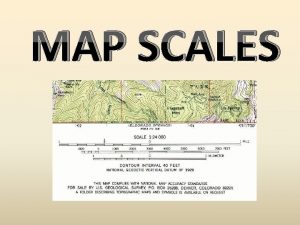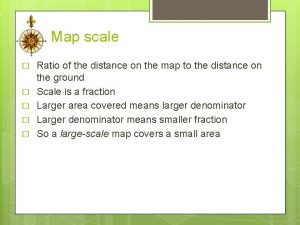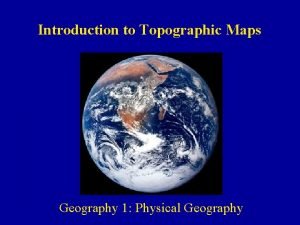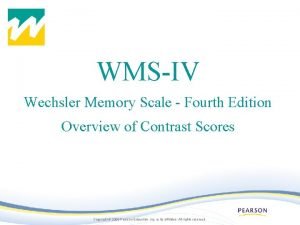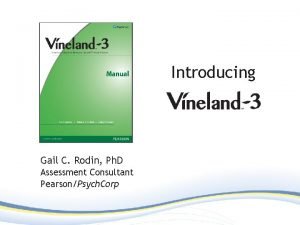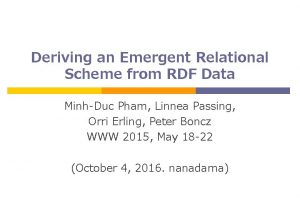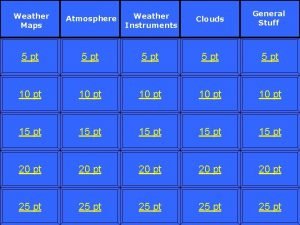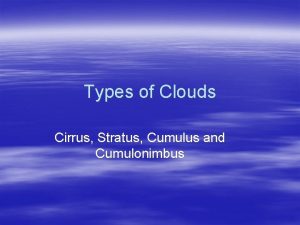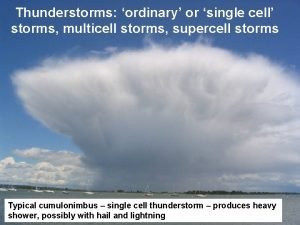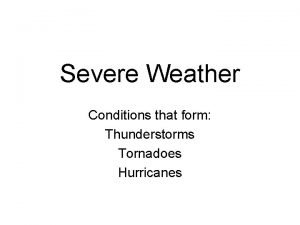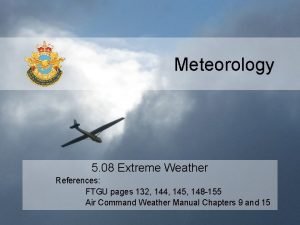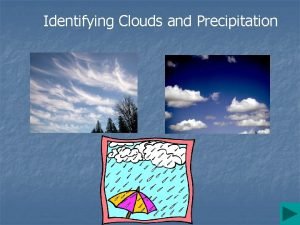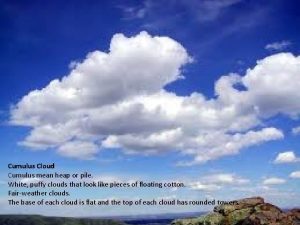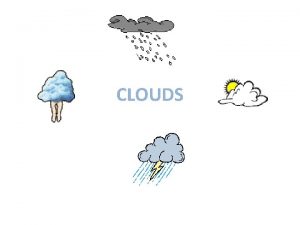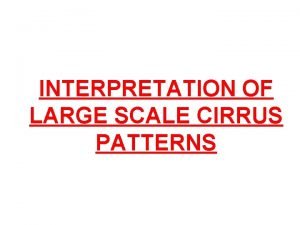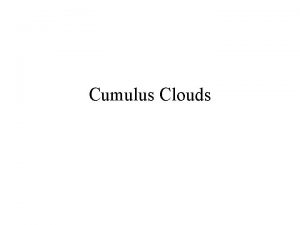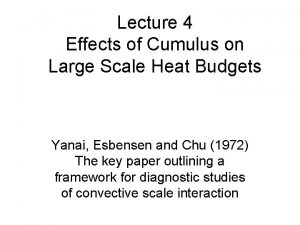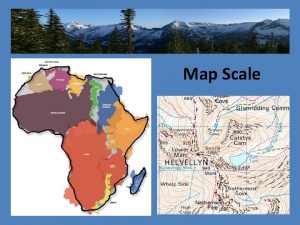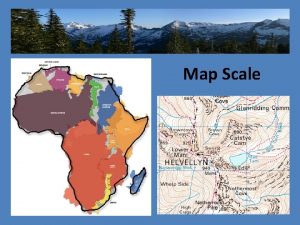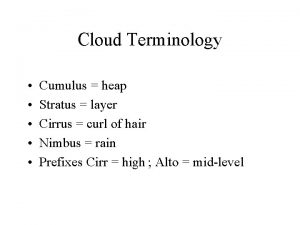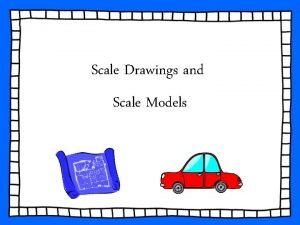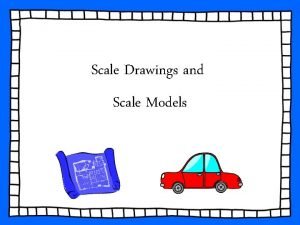INTERPRETATION OF LARGE SCALE CUMULUS CLOUD PATTERNS INTERPRETING

























- Slides: 25

INTERPRETATION OF LARGE SCALE CUMULUS CLOUD PATTERNS

INTERPRETING PATTERNS OF CU CLOUDS Cu cloud patterns provide info about surface and UA features over the ocean in areas of CA. Provide info about : Locating thermal troughs Locating upper short-wave troughs Locating jet-stream axes Locating surface ridges

LOCATING THERMAL TROUGHS Fig 1(a) ERICA storm # 4 at 1331 UTC on 04 Jan 89 : Vis image superimposed with 1000 -500 h. Pa at 12 gdm intervals

LOCATING THERMAL TROUGHS (b) Enhanced IR image with 500 h. Pa heights superimposed at 12 gdm intervals

LOCATING THERMAL TROUGHS Surface Analysis

LOCATING THERMAL TROUGHS v. Thermal troughs (as defined by the 1000 -500 hpa thickness pattern) are associated with large scale oceanic cyclones v Can be located using the cumuliform cloud pattern in areas of CA. v Fig. 1 shows an intense marine cyclone investigated in ERICA project (Hadlock and Kreitberg, 1988). v The axis of the coldest air (A-B-C) extends through the area of open cell having the largest diameter, thickest cloud walls and coldest tops.

LOCATING THERMAL TROUGHS v. If the instability is extreme through a deep layer, the open cell pattern becomes obscured (such as at D, which is over the warm waters of the Gulf Stream). v Closed cell appear at E, aligned with the strong surface wind flow. v. They occur most often downwind of upper troughs where PVA is a maximum.

LOCATING THERMAL TROUGHS v. Areas of enhanced Cu, usually in a northwesterly flow, are associated with a PVA area and a shallow surface trough where no closed surface low has yet developed. v On the jet side (or just to the rear) of the enhanced Cu pattern, stronger surface wind are often present. v Fig. 2 gives an example of an area of enhanced cumuliform cloud (labelled A) in a trough with a relative weak flow. v. Fig. 3 shows enhanced cumuliform cloud (A) in strong flow.

LOCATING THERMAL TROUGHS Fig 2 GOES IR image at 1200 UTC on 22 May 90 showing enhances convective cloud in a trough with weak low level flow. Enhanced convective cloud is at. A. Solid lines are isobars and dashed lines are 1000 -00 h. Pa thickness in gdm. Thick dashed line is a surface trough.

LOCATING THERMAL TROUGHS Fig 3

LOCATING THERMAL TROUGHS Fig 4(a) : Cumuliform cloud pattern in a confluent thermal trough at 1800 UTC on 17 Dec 91 Meteosat Vis image

LOCATING THERMAL TROUGHS Fig 4(b) : Cumuliform cloud pattern in a confluent thermal trough at 1800 UTC on 17 Dec 91 Meteosat IR image

LOCATING THERMAL TROUGHS Fig 4(c) : Surface analysis and (dashed) 1000 -500 h. Pa thickness(gdm). There is strong vertical shear at V

LOCATING THERMAL TROUGHS Fig. 4 shows cumuliform cloud in a strong low-level flow with no enhanced area of convection. In this case thermal trough was confluent. The strong vertical shear within the convective layer is seen to the west of the frontal cloud band (at V) in the elements lying southwest to northwest, almost parallel to the thickness lines.

ENHANCED CLOUD MODEL : DIFFLUENT THERMAL TROUGH Fig. 5: Red dashed lines are thickness. The circled cross indicates the vorticity centre

CUMULIFORM CLOUD PATTERNS AND THERMAL TROUGHS Area Feature A Large, open cellular clouds with polygon shape B Open cellular clouds organised into horseshoe shapes or blown-out ellipses C Boundary separating open and closed cellular clouds D Closed cells in the form of linear rolls (Sc cloud type) E Inference Deep cold air with little vertical wind shear (thermal gradient). Helps define the axis of thermal trough Deep, cold, unstable air with vertical shear. Direction of shear vector points into the open end of each incomplete ellipse. It gives a rough indication of the 1000 -500 hpa thermal wind and the jet; (for more precise location of the jet see section 3. 3. 4) Moderate to strong low-level vertical shear, aligned approximately in the direction of the cells. Indicate inversion due to subsidence. if cells are discrete and fairly circular, the vertical wind shear (thermal gradient) is small Fused cluster of large PVA area just ahead of upper through axis. in this Cu or Cb clouds synoptic situation, absence of this deeper convection implies absence of PVA, probably in a confluent thermal trough

LOCATING UPPER SHORT-WAVE TROUGHS Short-wave upper troughs in northwesterly airflows, upstream of long-wave troughs, can often be detected by areas of enhanced Cu which develop in regions of open cellular clouds (Fig. 5). These enhanced Cu have colder cloud tops than the surrounding convective cloud, and the cloud amount increases with time. These areas are immediately to the cold side of a jet axis in an area of ascent caused by PVA in advance of short-wave upper trough. The area of enhanced cu is usually 3 -5° latitude in diameter.

LOCATING JET-STREAM AXES When there are no clouds with tops at jet-stream level, the jet axis may often be related to a boundary or interface between different types of low-level cloud, due to the differences in the inversion level. The temperature of the cloud tops will be higher on the warm air side of the jet-stream axis. The reasons for the differences in cloud structure result from the differences in stability of the air on the either side of the jet, the air being more unstable on the cold side, resulting in more and/or deeper convective cloud.

LOCATING JET-STREAM AXES Surface Isobar Fig. 6

LOCATING JET-STREAM AXES v. The jet-stream axis (Fig. 6(a))is approximately parallel to the boundary between open and closed cellular clouds in polar maritime air on the upstream side of an upper trough. v. The open cells indicate vigorous convection on the cold side of the jet. v. The closed cells indicate that convection is limited by an inversion, caused by subsidence or a lower position of the frontal inversion, and at this level the cloud tends to spread out.

LOCATING JET-STREAM AXES v. The jet lies 1 -3° poleward of the boundary. This guide-line commonly applies over oceans and is most likely to be helpful when the jet stream is : Well defined; In a channelled configuration (i. e. the contours and vorticity isopleths are parallel); extends over significant depth.

LOCATING JET-STREAM AXES Over the land, well marked boundaries in convective cloud are much less frequent because of local variations in available moisture, topographical effects and large diurnal effects. The jet-stream axis is parallel to the boundary between low Cu clouds on the cold side of the jet and clear skies on the warm side. This rule applies when the flow is cyclonic at low levels.

LOCATING SURFACE RIDGES v Over the oceans, surface high pressure centres cannot be reliably located from cloud imagery. v High pressure area are generally cloud covered, with closed cellular Sc in area of CA on the east side, and low stratiform clouds on the west side where warm air is being advected over cooler sea surfaces. v Over the ocean the cloud type is quite sensitive to sea-air temperature differences, so a knowledge of sea surface temperature and the orientation of the sea surface temperature gradients is helpful in interpreting the cloud patterns. v The pattern will give clues about the low-level wind flow, helping to define area of high pressure and ridge line. Fig. 7 shows three areas which illustrate this effect.

LOCATING JET-STREAM AXES

LOCATING JET-STREAM AXES (A) Mobile polar ridge (between two migrating depressions L 1 and L 2): low-level clouds, in the northwesterly flow east of the ridge axis, change from open cellular to closed cellular at the dotted line in Fig. 7. The ridge axis A is approximately parallel to the boundary, several degrees of latitude on the closed cellular side. The ridge is usually very close to the forward edge of the solid overcast from L 2 and near where low-level stratifrom cloud clears or changes to cumuliform. (B) Polar air surface ridge: the ridge is located where the convection is reduced as a result of subsidence behind the front. (C) Sub-tropical surface ridge: the ridge is located on the boundary between the trade wind Cu and the stratiform clouds formed where the air flows northwards over colder water.
 Cloud to cloud integration patterns
Cloud to cloud integration patterns Line scale geography
Line scale geography What is a map scale definition
What is a map scale definition Large scale vs small scale map
Large scale vs small scale map Introduction to topographic maps
Introduction to topographic maps Large scale vs small scale map
Large scale vs small scale map How does interpretation b differ from interpretation a
How does interpretation b differ from interpretation a Wechsler memory scale example
Wechsler memory scale example Physical mobility scale out of 45
Physical mobility scale out of 45 Morse fall scale score interpretation
Morse fall scale score interpretation Vineland basal and ceiling rules
Vineland basal and ceiling rules 5-point likert scale interpretation
5-point likert scale interpretation Likert scale interpretation example
Likert scale interpretation example Modified overt aggression scale score interpretation
Modified overt aggression scale score interpretation Pt weather chart
Pt weather chart Cumulus stratus cirrus and cumulonimbus clouds
Cumulus stratus cirrus and cumulonimbus clouds Ordinary cell thunderstorms
Ordinary cell thunderstorms Bill nye hurricanes
Bill nye hurricanes Cumulus stage
Cumulus stage Cumulus stage
Cumulus stage Cumulus mature dissipating
Cumulus mature dissipating Water drops
Water drops Clouds like heap of cotton
Clouds like heap of cotton How does cumulus clouds form
How does cumulus clouds form Cumulus cirrus stratus
Cumulus cirrus stratus Cloud types and names
Cloud types and names


